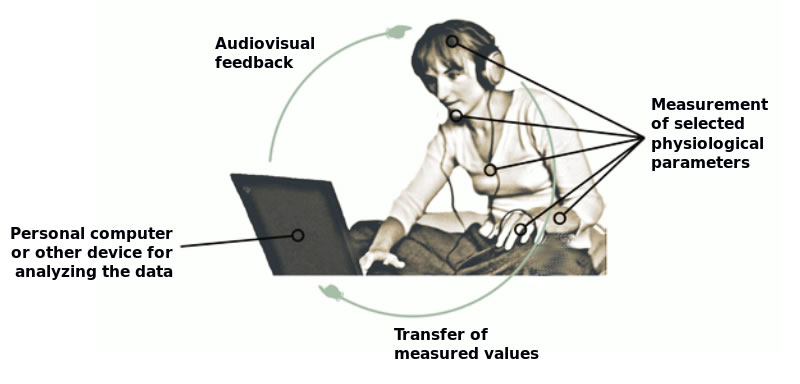
FAQ's About Biofeedback
 WHAT IS BIOFEEDBACK?
WHAT IS BIOFEEDBACK?
Biofeedback is a technique you can use to learn to control your body's functions, such as your heart rate. With biofeedback, you're connected to electrical sensors that help you receive information (feedback) about your body (bio).
This feedback helps you focus on making subtle changes in your body, such as relaxing certain muscles, to achieve the results you want, such as reducing pain. In essence, biofeedback gives you the power to use your thoughts to control your body, often to improve a health condition or physical performance.
Biofeedback is the process of gaining greater awareness of many physiological functions primarily using a medical interface that provides information on the activity of those same systems, with a goal of being able to manipulate them at will. Some of the processes that can be controlled include brainwaves, muscle tone, skin conductance, heart rate and pain perception.
HOW CAN BIOFEEDBACK HELP YOU?
Biofeedback may be used to improve health, performance, and the physiological changes that often occur in conjunction with changes to our thoughts, emotions, and behavior. Eventually, these changes may be maintained without the use of extra equipment. This method of stress detection and stress reduction is the most non-invasive therapy training available in energetic medicine today.
WHAT ISSUES CAN BIOFEEDBACK IMPROVE?
Biofeedback can be used when treating anxiety and worry, chronic pain, computer-related disorder, essential hypertension, headache (migraine, mixed headache, and tension-type headache), low back pain, physical rehabilitation (cerebral palsy, incomplete spinal cord lesions, and stroke), temporomandibular joint dysfunction (TMD), torticollis, and fecal incontinence, urinary incontinence, and pelvic pain.[20][21] Physical therapists have also used EMG biofeedback for evaluating muscle activation and providing feedback for their patients.
The Mayo Clinic has this to say about Biofeedback...
Biofeedback, sometimes called biofeedback training, is used to help manage many physical and mental health issues,
 - Anxiety or stress
- Anxiety or stress
- Asthma
- Attention deficit hyperactivity disorder (ADHD)
- Chemotherapy side effects
- Chronic pain
- Constipation
- Fecal incontinence
- Fibromyalgia
- Headache
- High blood pressure
- Irritable bowel syndrome
- Motion sickness
- Raynaud's disease
- Ringing in the ears (tinnitus)
- Stroke
- Temporomandibular joint disorder (TMJ)
- Urinary incontinence
- Sleep Cycle
- Sleep Disorders
- Injuries
-Medication Intolerances
WHY WOULD MY FAMILY OR I USE BIOFEEDBACK?
Biofeedback appeals to people for a variety of reasons:
 - It's noninvasive.
- It's noninvasive.
- It might reduce or eliminate the need for medications.
- It might be a treatment alternative for those who can't tolerate medications
- It might be an option when medications haven't worked well.
- It might be an alternative to medications for some conditions during pregnancy.
- It helps people take charge of their health.
- It balances the body on an energetic level relieving symptons
- It restores the flow of energy & raises the overall vibration of the body, cells & tissues
Biofeedback is generally safe for most everyone. Although, people with epilesy, pace makers or pregnant women must be worked on remotely. Be sure to talk to your doctor first.
WHAT ARE THE RISKS?
Biofeedback is generally safe. Biofeedback might not be appropriate for everyone, though. Be sure to discuss it with your doctor first.
WHAT CAN YOU EXPECT FROM A SESSION?
During a Biofeedback session, a therapist attaches electrical sensor straps to the head, wrists, and ankles. These sensors monitor your body's physiological state, such as brain waves, skin temperature, muscle tension, heart rate and breathing. This information is fed back to the practitioner via cues, such as a beeping sound or a flashing light.
The feedback teaches you to change or control your body's physiological reactions by changing your thoughts, emotions or behavior. In turn, this can help the condition for which you sought treatment.
For instance, biofeedback can pinpoint tense muscles that are causing headaches. You then learn how to invoke positive physical changes in your body, such as relaxing those specific muscles, to reduce your pain. The ultimate goal with biofeedback is to learn to use these techniques at home to help you manage your day to day stress.
HOW LONG IS A SESSION?
A typical biofeedback session lasts 90 minutes (not including consultation time). The length and number of sessions are determined by your condition and how quickly you learn to control your physical responses. Some individuals might need at least 10 to 15 sessions to get to the root cause of disease. Biofeedback might not be covered by insurance.
HOW MANY SESSIONS ARE RECOMMENDED?
It depends on the severity of the specific conditions.
WHAT CAN I DO TO PREPARE BEFORE AND/OR AFTER A SESSION?
Staying hydrated is key to a healthy life in general. Do yourself and your organs a favor and help aid in detox by simply drinking water throughout the day, especially on a session day. Biofeedback can release a lot of toxins and blockages in the body. It is recommended to have a restful day after the session to allow the treatment to set.
